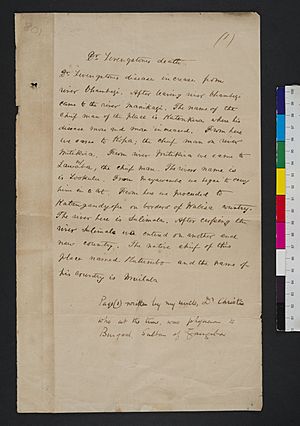David Livingstone Birthplace Museum facts for kids
The David Livingstone Birthplace Museum is a special place in Blantyre, South Lanarkshire, Scotland. It's all about the amazing life and adventures of David Livingstone, who was a famous explorer and missionary. This museum is run by the David Livingstone Trust. It's located in an old building called Shuttle Row, which is a very important historic place. This building is where David Livingstone was born on March 19, 1813. It was once part of a big textile mill where many families, including his, lived.
The museum has a huge collection of items that tell David Livingstone's story. You can learn about his childhood working in the mill and his incredible journeys across Southern Africa. The exhibits show his navigation tools, medical equipment, and even items from his family and the people he met.
Contents
Discovering David Livingstone's Story
How the Museum Began
People wanted to create a special place to remember David Livingstone. So, in 1925, a group started a committee to make a Scottish National Memorial to him. They bought the building where he was born, Shuttle Row, in 1927. A famous architect named Sir Frank Mears helped design the project.
The museum officially opened on October 5, 1929. A huge crowd of 12,000 people came to see it! Elizabeth Bowes Lyon, who was the Duchess of York at the time and later became the Queen Mother, opened the memorial.
Before the museum was created, the old mill buildings, including Shuttle Row, were in bad shape. In 1913, which was 100 years after Livingstone was born, the buildings were even declared unsafe to live in. People like Sir Frank Mears and Rev. James I. MacNair worked hard to save Shuttle Row. They wanted to turn it into a memorial and a place for visitors. They launched an international appeal to raise money.
On June 5, 1927, the committee successfully bought the site. This allowed them to start working on Shuttle Row and gather more items for the collection. The 'Scottish National Memorial to David Livingstone Trust' (DLT) officially became a legal charity in 1930.
How the Museum is Run Today
For many years, starting in 1999, the museum was managed by three groups working together: the National Trust for Scotland (NTS), South Lanarkshire Council (SLC), and the David Livingstone Trust. The NTS managed the museum and its collection, while the council took care of the wider grounds.
Since April 2017, the David Livingstone Trust has been fully in charge of running the museum. They have done a great job getting a £6.3 million grant to make the museum, its collection, and the cafe buildings even better. This big project has been supported by the Heritage Lottery Fund, Historic Environment Scotland, and the Scottish Government.
What You Can See at the Museum
Objects from Southern Africa
David Livingstone wrote and drew many things during his trips. These writings tell us a lot about the cultures, people, and places he encountered in Southern Africa. Other people who knew Livingstone also wrote diaries. For example, Jacob Wainwright made a list of Livingstone's belongings right after he passed away. This list is in Livingstone's last field diary.
Items from Blantyre Cotton Works
The museum also collects items related to the Blantyre Cotton Works. This is important because it helps us understand David Livingstone's early life, his family, his home, and his work. This collecting started in 1927 when they got the 19th-century Blantyre Works Library.
Over time, they added many objects from the mill. These include things like bobbins used in the mill, a handkerchief made there, the mill's bell, and even the boardroom table. There are also models of the Blantyre Works, like one made by Charles d’Orville Pilkington Jackson, and a spinning jenny machine.
Artworks and Sculptures
The museum features many artistic pieces that help tell Livingstone's story.
- Pilkington-Jackson: Charles D'Orville Pilkington Jackson created several bronze sculptures that show scenes from Livingstone's life. He also made a "World Fountain" in the museum grounds before it opened in 1929. Later, in 1930, he carved an oak sculpture called "The Last Journey."
- Haswell-Miller: The museum's founders wanted to have imaginative displays that told Livingstone's story. They hired Archibald Eliot Haswell Miller to create artworks for the galleries. He painted a series of 8 wall panels using a special paint called tempera. These panels told the story of Livingstone's early life and were put up before the museum opened in 1929. Later, he added four more murals. These murals were paid for by various Christian, youth, and educational groups across Scotland. Since 1932, the museum has collected 19 works by Haswell Miller, including paintings on canvas and board, all related to David Livingstone's life.
Blantyre Works Library
The Blantyre Works Library is a special collection of books from the 18th to early 20th centuries. These books were available for the workers at the Blantyre Works Mill to read. David Livingstone and his family would have had access to these books when they lived in Shuttle Row in the 1800s.
Images for kids
See also
- List of Category A listed buildings in South Lanarkshire
- List of listed buildings in Blantyre, South Lanarkshire
- List of museums in Scotland




